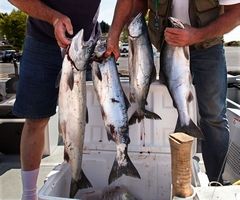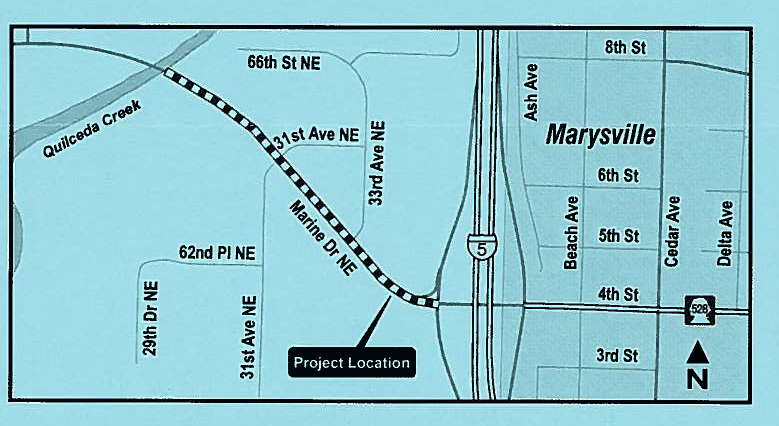
Phil Flick (left) and Tom Goggin, both of Lynnwood, show four of their seven pink salmon, one shy of their limit, to Jeff Lowery of the Washington State Fish and Wildlife Department after pulling their boat out at Mukilteo last week.
Bill Sheets, The Herald
EVERETT — Every odd-numbered year, visitors to local shorelines in late summer are often struck by the sight of an extraordinary number of small boats on the water.
They might also see people standing along the beach with fishing poles in their hands.
“Everyone hears the word ‘pink’ and they just want to come out and join the rat race,” fisherman Nigel Anders of Arlington said as he launched his boat in Mukilteo recently.
While some species of salmon and trout are struggling to survive — Puget Sound chinook and steelhead are both listed as threatened under the federal Endangered Species Act — pink salmon and other species are thriving or holding steady.
Every major species of Pacific salmon and trout can still be found in Snohomish County waters — chinook, coho, chum, pink and sockeye salmon, along with rainbow and cutthroat trout. A species of char, called a bull trout, is found here as well.
There’s also a large sturgeon population that visits Port Susan, near Stanwood, according to state fish biologists.
These fish are all anadromous, meaning they travel into streams to spawn, and spend the bulk of their lives in saltwater. The salmon, trout and char are part of the salmonid family.
“We have a lot of fish here and a lot of water,” said Justin Spinelli, a biologist for the state Department of Fish and Wildlife.
Each river, stream and lake has its own unique, colorful mix of fish. The Snohomish River, for example, is home to one of the largest coho populations on the West Coast, generally exceeded only by the Skagit River and the Columbia, said Mike Crewson, fisheries enhancement biologist for the Tulalip Tribes.
Sockeye salmon — a small, tasty variety — are best known in this area for their large runs in Lake Washington and its tributaries, some of which reach into Snohomish County. Baker Lake in the North Cascades has a large population, as well. But sockeye also are found, at least in small numbers, in most other local rivers, biologists say. A large population of landlocked sockeye, or kokanee, swim in Lake Stevens.
Sockeye turn bright red before spawning, earning them the nickname “red salmon.” Coho salmon are known as “silvers” for their clean, shiny look. Rainbow trout are aptly named, with their scales reflecting a multi-colored hue. Cutthroat trout are named for a red strip that runs along the underside of their heads behind their mouths.
Pink salmon are named for the color of their flesh. The smallest of the Pacific salmon, they’re also called “humpies” because their backs develop a prominent hump before spawning.
What pinks lack in size or flavor compared to other salmon species, they make up in numbers. More than 6 million humpies are forecast to return to rivers in the Puget Sound region this year. That’s well shy of the record of 9.8 million pinks set in 2009, but this year’s run is still on the high side, state wildlife officials say. State records go back to 1959.
Of those expected back this year, nearly 1 million pinks are forecast to head for the Snohomish River to spawn and 400,000 more are forecast to return to the Stillaguamish River. About 1.2 million are expected in the Skagit River
Pinks can be caught both in saltwater and in the rivers. Saltwater and the Snohomish River are open to pink salmon fishing now. The season opens in the Stillaguamish and remaining areas on Sept. 1.
Humpies have a shorter life cycle than other salmon, returning to spawn after two years. While most return in odd-numbered years, some do return in even-numbered, “off” years, Crewson said.
Pinks currently have a combination of advantages working for them over other salmon species, biologists say.
They can spawn in more places, do it more quickly, head straight for saltwater after hatching and spend less time there once they arrive.
This makes them less susceptible to the habitat destruction and changing ocean conditions that can push down survival rates of other species.
Humpies can spawn in the tiniest of streams, Crewson said.
“Pinks can go up anything that’s flowing,” he said.
Juvenile chinook and coho stay in fresh water and grow for up to a year and a half after they’re hatched before heading to sea. Pinks head out in a matter of days, biologists say. That helps pinks avoid the ravages of urban runoff, which can scour and pollute salmon-bearing streams.
In saltwater, the issues are more complex, but survival rates there have been on the decline, biologists say.
Fish depend on upwelling of plankton from the lower reaches of inland waters and the ocean. These organisms form the base of the food chain for salmon and trout.
These upwelling patterns have become more erratic, especially in the Puget Sound basin, biologists say, creating more of a hit-and-miss proposition for the fish.
The causes haven’t been nailed down, but climate change is believed to play a part, Crewson said. More rain and less snow falls in the mountains, creating more flooding. This can affect upwelling along with habitat, he said.
“Changes in stream-flow patterns can alter when plankton blooms happen and when fish go out,” Crewson said
Pink salmon have been hitting the plankton blooms better lately than the other fish, he said.
“An early outmigrating salmon has got an advantage,” Crewson said.
El Nino conditions, in which warmer water moves northward from the central Pacific, also can throw food chains out of whack, he said.
Seals and sea lions also are suspects in falling survival rates for salmon. Populations of the fish-eating mammals have been increasing in the Puget Sound area in recent years.
Trout, like larger salmon, require longer rearing periods in fresh water. Puget Sound-area steelhead — rainbow trout that go to sea — have been having trouble getting there, biologists say.
Some have been planted with electronic tags and can be counted when they run across any of several electronic beams sent across the water along Admiralty Inlet and the Strait of Juan de Fuca. Many are disappearing before they get to these points, biologists say. That means the steelhead aren’t heading out to the Pacific Ocean.
“There’s something drastically wrong when you lose that many fish,” Crewson said. “Our steelhead numbers (in the Snohomish basin) have been way down.”
The other primary trout species in the area, cutthroats, are holding steady, said Brett Barkdull, a state fish biologist based in La Conner.
Some of these trout stay in rivers, while those that venture into saltwater, known as sea-run cutthroat, don’t go as far afield as steelhead, Barkdull said. They tend to stay in bays and estuaries.
The sea-run cutthroats, while smaller than steelhead, are prized by many serious anglers for their fighting ability. They once were overfished, Barkdull said. In 1990, strict limits were placed on their harvest. Those regulations have helped the fish recover, but still in many areas now they are allowed to be caught but not kept, or may be kept only if they’re above a certain size.
Because of those rules, cutthroat trout tend to be overlooked by casual anglers, said John Martinis, owner of John’s Sporting Goods on Broadway in Everett.
“They’re a very, very popular fish among the fly fishermen,” he said.
Fish populations in the Skagit River are generally healthier than in the rivers in Snohomish County and others in urbanized Puget Sound, Barkdull said.
Many of the Skagit’s upstream waters are in North Cascades National Park or national forest land, he noted.
“I think part of that has to do with the fact that a lot of the rearing habitat is protected,” he said.
In general, numbers for all the fish in the Puget Sound region are down from historic levels, Crewson said. Some, like the pinks, are bouncing back, and that’s good news for people who like to fish.
“It’s one of those opportunities where novice anglers as well as experienced anglers can do really, really well,” Martinis said.
Learn more
For more information, visit the state Department of Fish and Wildlife’s information page on salmon and trout at http://tinyurl.com/ozu787a.










